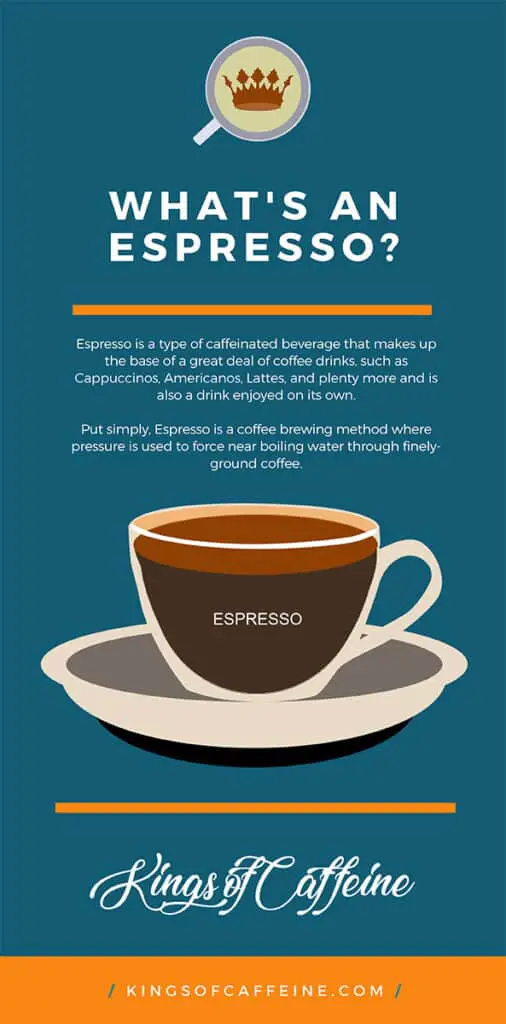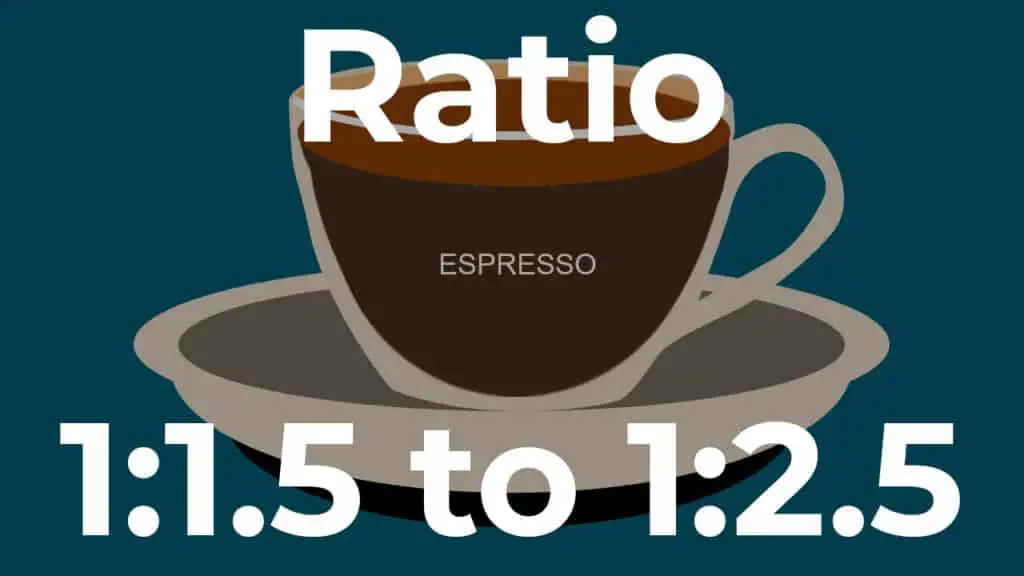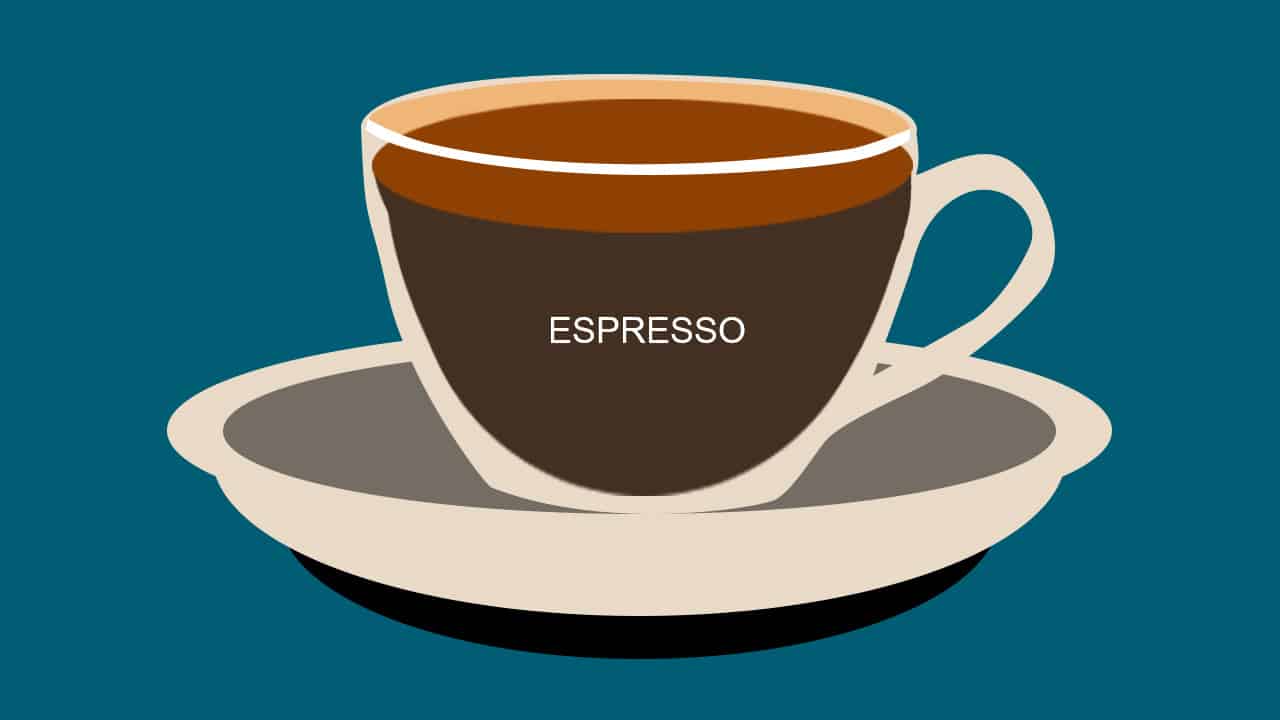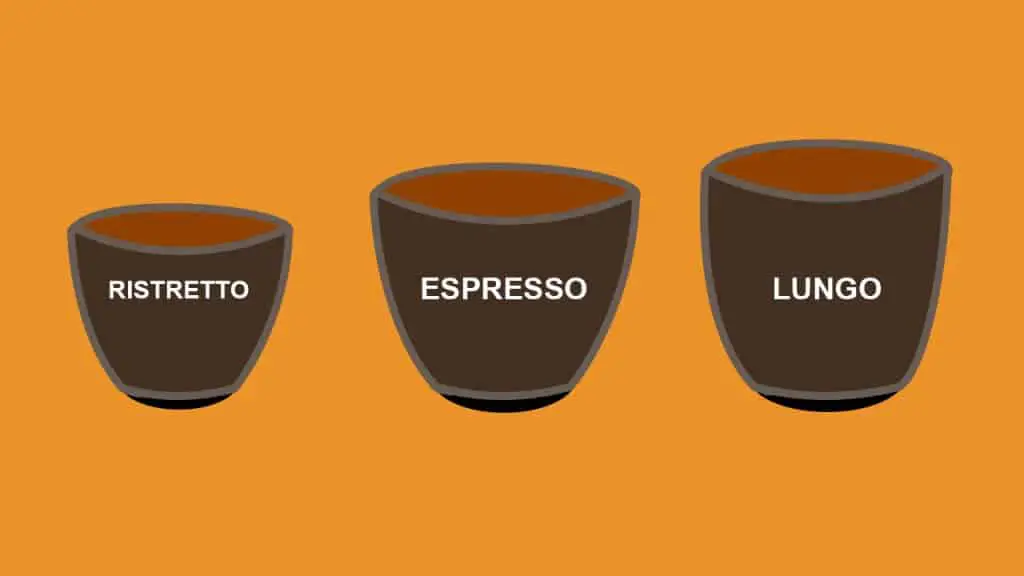The most loved of the coffee brewing methods, so sacred that some people see it as an art form.
But it doesn’t have to be complicated.
Here at Kings of Caffeine, our aim is to make you as educated as possible in the world of coffee.
We will explain in clear and concise language everything you need to know, including all the information you need to make a perfect Espresso.
Now, no more delay, let’s jump in!
Skip to a section:
Espresso is a type of caffeinated beverage that makes up the base of a great deal of coffee drinks, such as Cappuccinos, Americanos, Lattes, and plenty more and is also a drink enjoyed on its own.
Put simply, Espresso is a coffee brewing method where pressure is used to force near boiling water through finely ground coffee.

Share this Image On Your Site
The origins of Espresso can be traced back to Italy in 1884 with a patent for a machine invented by Angelo Moriondo of Turin.
The problem was (and still is) that coffee takes a long time to brew, by grinding finer you can decrease its brewing time but by doing that you are increasing the density of the bed of coffee, which the water will find harder to penetrate.
Angelo Moriondo saw this problem as an opportunity and developed a machine that utilised steam to push the water though the grounds, allowing for a faster brew time.
The patent was then built on in 1903 by Luigi Bezzera and then again later, by Desiderio Pavoni.
Bezzera and Pavoni worked separately, until collaborating for a showcase at the 1906 Milan Fair, where they introduced what they called ‘Caffe Espresso’ to the world.

The name ‘Caffe Espresso’ comes from the word ‘caffe’ which translates from Italian to coffee and ‘Espresso’ which comes from the speed at which the coffee is expressed/water pushed through.
This was the first time the world had seen fast coffee and would mark the beginning of the Espresso machine industry, even though this coffee was not the Espresso we know today and was more of a brewed coffee, as these machines were only harnessing about 2 bars of pressure.
In 1938 that all changed, when a machine was created that could push water through a coffee bed at approximately 9 bars of pressure, this changed the Espresso forever. The machine was accredited to a Milanese café owner named Giovanni Achille Gaggia. He was the first to make an Espresso that we would recognise today!
When Espresso is done right it is has a vibrant and complex flavour combined with a lovely, silky texture.
A balancing act between flavours of bitterness, acidity and sweetness.
The type of coffee will have a strong impact on the flavour, which, depending on the coffee used, might bring about more fruity or chocolatey notes, for example.
Crema is the light brownish coloured foam that commonly sits on top of an Espresso and all though it has its controversies it is commonly viewed as a good indicator of high quality Espresso.
The production of crema is a combination of a couple of elements. The first being that after coffee is roasted it will begin to let off CO2 for a small period of time. Some of this CO2 is released when the water is pushed through the ground coffee producing small bubbles. At the same time this process releases some of the coffee’s oils and other molecules, the molecules help stabalise and reinforce the bubbles, preventing them from popping immediately and the oil mixes into the foam helping enhance its creaminess.
Before we can understand how to make Espresso, let’s start at the very beginning and discuss the aim of what we are doing.
Before that though, I just want to mention that the perfect Espresso is an extremely subjective thing which will be different for everyone. Therefore this is not a ‘plug-and-play’ recipe, that you will follow to a tee, but more of a guide that will give you all of the information necessary to get to a ‘good’ Espresso – to push it to a ‘perfect’ Espresso will be down to you to tinker. I will explain the how, what, whys of the tinkering though, so don’t worry.
The aim when making Espresso
The aim when making Espresso is to get the soluble material out of the ground coffee and into the cup below, but to do this you need a solvent, in this case that is water.
The more soluble material you can pull from the coffee the better the coffee will taste, as the soluble material contains all the delicious stuff, though only up to a point, after which the coffee will begin to get worse.
This is why we take careful command of the different variables we can control when making our Espresso.
But, what variables can we control?
The variables under our control in the Espresso making process are:
One more extremely important thing to keep in mind when making Espresso is repeatability, this is another reason we are very careful with how we control these variables. We need to make sure we are precise, that way we can guarantee great coffee every time when our process is perfect and when it is not, we can make the necessary adjustments and track the difference each adjustment makes.
Coffee
This might be the most obvious point made in this guide, but the quality of your coffee is very important in how your Espresso shot will taste. I won’t dive to heavily into how to ensure you are buying quality coffee here, this will come in a future article, but I will give some basic points to look out for.Buy fresh!
As a general rule of thumb, the fresher the coffee the better it is. Ageing coffee can lose flavour, aromatics and even develop nasty tastes if it has begun to go stale.
The age of a coffee is best gauged by the roast date, which you can usually find on the side of the pack, though some coffees (usually supermarket sold) will only have a best before date.
A best before date is pretty useless as it gives no indication of when the roasting took place and as coffee is food safe for a really long time, there is no telling how old it is.
To be honest it probably will still taste ‘good’, but you want it at its best!
Coffee for Espresso is best left to rest for around 7 – 10 days before brewing as it holds a lot of trapped CO2, which is released during the pressurised brewing process, this negatively affects the result.
One more point to note with regards to freshness is that buying whole beans and grinding yourself will give a better result, as you can grind your coffee fresh as part of your process.
Pre-ground coffee is still great but has one big negative. Once you open the bag and the vacuum seal is broken, the air rushing into the packet will immediately begin its aging process. Therefore, the coffee you use immediately will be great, but the quality will slowly diminish over time.
Like I said before it will still taste ‘good’, but you paid for it, you want it to be at its best!
Buy Traceable!
The last bit of coffee buying advice I’ll leave you with is this:
If your coffee has a specific point of origin, for example, a farm or at the larger end of the spectrum, a region, it will generally be better quality coffee then that which only refers to a country of origin.
For one thing coffee can differ a lot over an entire country, so while that fact gives you some information about the coffee itself, it is still quite vague – and two, tracing a coffee all the way back to a specific point of origin adds expense to the producer. This cost will be passed onto the end consumer, which means the coffee must be worthy of its higher price point or people just won’t buy it. This would give a poor return on investment for the producer and not worth the extra effort it takes to make it traceable in the first place.
Quite simply the better your coffee gear is, the better job it will do and the more consistent it will be.
That is not to say the most expensive gear is the best, I have actually found that not to be the case in many instances.
The equipment which has the greatest impact on your Espresso is:
The coffee grinder
What to look for in a great Espresso grinder
The coffee grinder is an extremely important piece of equipment in the Espresso making process.
A great coffee grinder has great control and precision.
Its control allows you to grind fine enough to make Espresso and the precision allows you to achieve a uniform grind.
I’ll go in to this more in the Grind section below or skip straight there by clicking here!
If you are in need of an excellent Espresso grinder, I have listed some below.
The Espresso machine
What to look for in a great Espresso machine
Grinding finer allows you to unlock more of the coffee and will provide a density, after the ground coffee has been tamped, which the water will find hard to penetrate. This allows for a greater contact time between the small amount of water used and the coffee, and one of the reasons that Espresso has its distinctive consistency and taste.
Grinding too fine, will have a negative impact on the Espresso, as a grind too fine will cause the water to channel through the coffee at uneven rates – once again it is a balancing act.
You can easily tell if this channelling has occurred by watching the coffee coming out the bottom of your portafilter, as you will be able to see the flow changes. Also, when tasting your Espresso, if you have ground too fine it is likely to have very bitter and acidic flavours and taste a bit weaker than you’d expect.
As a general rule you want to try and grind as fine as you can before channelling occurs.
If your resulting Espresso shot is tasting too sour take your grind a little finer, if things are a little too bitter or harsh then maybe come back a little bit coarser.
The uniformity of the ground coffee is hugely important too as this will provide an even bed for the water to flow through, meaning no place in the coffee puck is more dense than anywhere else. This is important as the water will try and move through the path of least resistance, but we want it to move through the puck evenly.
As a side note, if you change your grind size, make sure to purge about 5g of coffee from the grinder first, as the machine will not have gotten rid of all of the coffee from the previous grind setting and you want your grind to be uniform!
Puck preparation can be an overlooked factor in making great Espresso.
Before the ground coffee goes in, please make sure your basket is clean and dry!
Other than that, as mentioned in the grind section, your puck preparation is about trying to get the ground coffee as even as possible in the basket.
There are a few different ways you can do this, but most people just use their finger to even it out.
There are some tools that can help, which I’ve listed below.
Next you will want to tamp the coffee – this is done by pressing the tamper directly down, on top of the coffee grounds, this ensures the ground coffee remains nicely distributed and again, ensures the water will move through the coffee evenly.
Tampers we love!
When doseing your ground coffee, it is important to be using the correct basket size.
So if your basket is 18g, dose 18g.
Another important thing is to have accurate scales to hand so you can weigh what you have dosed, make sure that 18g of ground coffee weighs 18g.
The amount of water used to brew Espresso is usually talked about in terms of Espresso ratios.
Basically, an Espresso ratio refers to the amount of liquid that ends up in your cup, which correlates to the amount of ground coffee you started with.
Something like 1:2, which would mean if you started with 9g of ground coffee, you would yield 18g of liquid espresso.

In Espresso brewing we like to use weight instead of a volumetric measurement i.e. grams instead of millilitres, due to the crema.
Crema is made up of gas and foam and takes up more volumetric room, thus reducing the amount of liquid coffee in a set volumetric measurement.
Crema isn’t constant either, for example if the coffee is older, there will be less crema, and therefore more liquid coffee in the resulting Espresso.
A weight measurement more accurately takes into account the liquid coffee, in this way making your process much more consistent and repeatable.
To find out more about crema, click here!
This is only guidance, but it is commonly accepted that an Espresso ratio is somewhere between 1:1.5 and 1:2.5.
This will produce an Espresso shot with all the strength, texture and flavour that we know and love.
The common Ristretto ratio is somewhere between 1:1 and 1:1.5 and the Lungo ratio 1:2.5 to 1:4 plus!
You can find out more about Ristrettos and Lungos at our article below:
What’s The Difference Between ESPRESSO, RISTRETTO and LUNGO?
If you have read this guide up to this point…
First off congratulations – it has been long!
Secondly, everything I have spoken about above will allow you to dial in your perfect Espresso.
But just in case you are still looking for a place to begin, I’ll give you a nice place to start from which you can start tweaking!
A quick note on the tweaking, if you are adjusting any variables make sure to only adjust one at a time. If you adjust more than one you won’t be able to track the differences your changes are making!
Espresso Recipe
- Begin with a dose of 18g of fine ground coffee
- Level out the coffee by moving it around the basket with the side of your finger
- Compact the grounds with a tamper
- You are looking to produce 36g of liquid Espresso (2:1 ratio)
- If you have ground fine enough the extraction time should be around 30 seconds
That’s it!
We hope our guide answered any Espresso related questions you may have had. Now go and make some coffee!
As always if you have any questions or feel like we have missed anything please send your questions/suggestions to [email protected]
Small Notice
If you click on any of our Amazon links and make a purchase, we earn a commission at no additional cost to you!

















